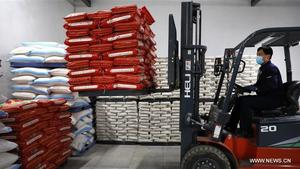 A worker operates a forklift to convey rice at a rice company in Anshan City, northeast China's Liaoning Province, March 9, 2020. (YAO JIANFENG / XINHUA)
A worker operates a forklift to convey rice at a rice company in Anshan City, northeast China's Liaoning Province, March 9, 2020. (YAO JIANFENG / XINHUA)
BEIJING - China's consumer price index (CPI), the main gauge of inflation, grew 5.2 percent year on year in February, the National Bureau of Statistics (NBS) said Tuesday.
The reading, in line with market expectations, eased slightly from the 5.4-percent gain in January. On a monthly basis, consumer prices edged up 0.8 percent.
ALSO READ: Inflationary pressures stay subdued in China
Food prices went up 21.9 percent year on year last month, contributing 4.45 percentage points to the index rise as the novel coronavirus outbreak disrupted market supplies and demands
Food prices, which account for nearly one-third of weighting in China's CPI, went up 21.9 percent year on year last month, contributing 4.45 percentage points to the index rise as the novel coronavirus outbreak disrupted market supplies and demands.
Restrictions on flows of transport and people, as well as business closures during the period have affected food supplies, while rising demands among stay-at-home residents to hoard foods combined to push up prices, NBS official Zhao Maohong said.
In the first two months, CPI went up 5.3 percent year on year on average, up 3.7 percentage points from the same period last year.
PPI down 0.4% in Feb
China's producer price index (PPI), which measures costs for goods at the factory gate, dropped 0.4 percent year on year in February, according to the NBS.
This compares with a 0.1-percent growth recorded in January, according to the bureau.
On a monthly basis, the PPI wend down 0.5 percent, said the NBS. For the first two months, the PPI on average declined by 0.2 percent from the same period last year.
Zhao Maohong, an official with the NBS, attributed the price decrease to seasonal factors and the outbreak of novel coronavirus that led to extended holidays, depressed factory activities and disrupted transportation across the country in the reporting period.
The sharp price decline in the international oil market last month has also prompted the PPI drop, according to Zhao. Producer price plunge in oil-related industries including petroleum and natural gas exploitation and chemical goods manufacturing dragged the overall PPI down by 0.44 percentage points.
READ MORE: Pessimism over economy unwarranted
Bucking the trend, producer prices for the medical manufacturing industry increased in February despite efforts to ensure the production of medical supplies and protective gear.
Lifted by increased raw material prices and logistics costs, the PPI for medical manufacturing climbed 0.3 percent month on month. For disinfection products and hygienic materials, the PPI went up 14.8 percent and 1.5 percent, respectively.


